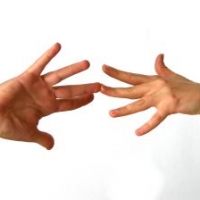The Future of Touch Technology: Feel Textures on a Flat Screen

Touch technology is pretty ubiquitous these days, from smartphones to tablets and even to laptop screens. While the ease with which you can swipe and tap icons and displays is convenient and intuitive, there’s one area where it’s lacking: your sense of touch.
There is no physical feeling the way there is with buttons and keys. But it looks like that could be changing. The Walt Disney Company research wing in the field of tactile, or “haptic,” devices recently announced new developments that will let users feel textures on a touchscreen.
That means in the coming years, you could be typing on your smartphone’s screen and feeling the outlines of the keys; lifting some weight with a little resistance when dragging files and having it release when they’re dropped into a folder; and getting the sensation of texture on icons and photos.
The technology is called TeslaTouch. No moving parts are involved; it uses electrovibration to produce a slight static force that delivers the feeling of friction between your finger and the screen.
“It's kind of like a buzzing or a vibration. It has the same effect as a buzz,” Chris Harrison, one of the Disney researchers and a Ph.D. student at Carnegie Mellon University, told CNN. “But if you carefully tune the frequency and the vibration of the panel you can actually create things that feel like sandpaper or rubber or a wall.”
If this is sounding futuristic, just wait—it gets even more like science fiction. Disney Research also is working on tactile equipment that doesn't require any actual physical contact at all. The device, called the Aireal, reacts to your movements similar to the way the Xbox Kinect gaming system does, but it blows small rings of air at you during these interactions. The puffs of air can simulate touch, movement, or even bumps and collisions.
“I love this work—very well done,” Ivan Poupyrev, the principal research scientist at Disney Research, told CNN. “In general, creating tactile feedback in free air is a very important research direction.”
Development is underway on UltraHaptics, a similar project created by a team from the University of Bristol’s Interaction and Graphics research group. UltraHaptics also lets you feel sensations without actually touching anything, but instead of blowing small blasts of air at you, it uses ultrasound vibrations, basically giving you the feeling you get standing near an amplifier during a concert.
In the same way that touchscreens have become commonplace in only the last five years or so, it shouldn’t be long until you’re regularly feeling textures on a completely flat screen and touching objects while grasping only thin air.

